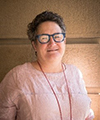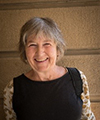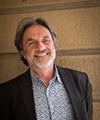The Panel is made up of six members and together bring a wealth of knowledge and real world experience in landscape architecture, planning, urban design and architecture.
The Panel:
- Chairman with suitable urban design and public administration experience
- The Tasmanian State Architect (currently vacant)
- Member who currently holds an academic position in urban design
- Nomination from the Tasmanian - Australian Institute of Architects
- Nomination from the Tasmanian - Australian Institute of Landscape Architects
- Member with both planning and urban design expertise
The Panel work with the City of Hobart Urban Design Advisory Panel Liaison Officer.
All members are required to declare if they have a conflict of interest and may not take part in any panel meeting for which they have declared a conflict of interest.
Current members
Scott Balmforth
Position: Chairman - Urban design and public administration experience

Scott Balmforth was born and raised in Hobart and is a founding Director of TERROIR. The practice was established in Hobart and Sydney simultaneously in 1999 and expanded internationally with TERROIR ApS in Copenhagen in 2010.
Scott graduated from the University of Tasmania and has an invited Masters of Architecture from RMIT University. He is a Registered Architect in Tasmania and Victoria, a former Australian Institute of Architects Chapter Councillor, and an Adjunct Professor of the University of Tasmania's School of Architecture since 2008.
Scott has led a range of innovative, award winning and internationally published architecture and urban design projects, and consistently champions in his work the place-based values and influences of his Tasmanian upbringing.
Appointed Chairman in late 2020, Scott brings to the City of Hobart's Urban Design Advisory Panel a unique local-to-global outlook, recognised design expertise, the ability to draw on local, national and international relationships and experience, and a strong advocacy to the City's future.
Yvette Breytenbach
Position: Member from the Tasmanian Chapter Institute of Architects

Yvette Breytenbach is a registered Tasmanian architect and a director of Morrison & Breytenbach Architects, Hobart. From 2017 – 2019 she filled the positions of President of the Australian Institute of Architects (AIA) Tasmanian Chapter, National Councillor on the AIA National Council and member of the Board of Architects Tasmania, a consumer protection body. She is a Tasmanian examiner for the Architects Accreditation Council of Australia (AACA) Architectural Practice Examination (APE), and an advocate for gender equity in the construction industry.
Yvette has been a jurist for the ACT Chapter AIA Annual Awards (2019), the Tasmanian Chapter AIA Emerging Architect Award (2017, 2018), the Australian Institute of Landscape Architects (AILA) Annual Awards (2007), and the Tasmanian Chapter AIA Annual Awards (2003).
She grew up in South Africa, graduated from the University of Witwatersrand in 1980 with a Bachelor of Architecture and practised in Johannesburg and Cape Town on residential, social housing and urban design projects. In 1988, she completed a Social Science Honours degree at the University of Cape Town. From 1989 she worked on a range of architectural projects in Cambridge, U.K., while completing a Certificate of Fine and Applied Art in Ceramics at the City of London Polytechnic. A lifelong interest in ceramics translates to her architectural delight in the use of materials, texture and play of scale, as well as of carefully crafted buildings and spaces.
With her husband, architect James Morrison, Yvette migrated to Australia and settled in Hobart in 1991, setting up their architecture practice in 1992. Morrison & Breytenbach Architects has subsequently been recognised with multiple awards both locally and internationally, including in the arts, educational, residential, university and social housing sectors. The practice has delivered two 6-star Green Star "as-built" Green Building Council of Australia (GBCA) certified buildings in Tasmania and integrates a strong social and environmentally sustainable focus into their work.
Yvette brings a voice for appropriate development of our built environment for the betterment of all Tasmanians. She advocates for protection of our built, natural and cultural heritage, equity in the built environment, people-focused quality design, and innovation that supports industry growth and a strong sustainable economy.
Matt Drysdale
Position: Member with Urban Design Experience

Matt Drysdale is a Tasmanian born, internationally experienced design strategist who shares his time between Melbourne and Tasmania.
Over the past 20 years, he has played a design leadership role internationally within Asia and locally with projects across Victoria, New South Wales, Queensland and Tasmania showcasing his expertise across various scales and typologies within the urban context.
Matt graduated from Deakin University in 2005, earning a Bachelor's degree in Architecture and a Bachelor of Arts (Architecture) and is a longstanding affiliate of the Royal Australian Institute of Architects. His unique skill set, honed through working with renowned master planners and architects, such as Daryl Jackson AO and Woods Bagot, positions him as a highly experienced multi-disciplined designer.
Matt's diverse experience spans strategic urban planning, architecture, urban design, master planning, heritage projects, development strategy, design, and public art. He has experience in many sectors including major projects, urban renewal, sport and recreation, community infrastructure, transport, social and affordable housing and defence.
Matt Drysdale's design approach is underpinned by a commitment to a collaborative approach to projects, being highly engaging and pragmatic.
Leading The OCD (The Office for Collective Design), Matt's strategic experience includes the delivery of development plans, master plans, feasibilities, strategic site assessments, development advice, conceptual designs, and completed projects.
Notable Tasmanian projects include the recently completed Hybrids urban public art project located in New Town and delivered as part of streetscape upgrades, a self-funded and detailed pre-emptive master plan for Macquarie Point in 2014 that explored mixed-use opportunities and the creation of a new waterfront cove located at Macquarie Point and strategic and design support for a community coastal trail project located at Eaglehawk Neck.
With a wealth of experience and a passion for contributing to the community, Matt is keen to further his work within the Tasmanian urban design and architectural landscape.
Helen Norrie
Position: Member with Academic Position in Urban Design

Dr Helen Norrie is a Senior Lecture in Architecture Design at the University of Tasmania. She has been an architectural critic for architecture, design and art journals for 25 years, and has authored catalogue essays for art and design exhibitions.
Helen is the founder of the Regional Urban Studies Laboratory (RUSL), a collaborative practice-led urban design research project that engages directly with local councils and communities to examine urban issues in small towns and cities. RUSL undertakes collaborative research that examines the spatial, temporal and social aspect of urban settlements, focusing on the intersection of development, planning and urban design. Drawing on spatial and data analysis, and evidence-based research she and the RUSL team develop speculative scenarios to explore how current policy frameworks can impede or promote new development that provides positive urban design outcomes.
Susan Small
Position: Member from the Tasmanian Chapter of Landscape Architects

Sue runs a Landscape Architecture practice from central Hobart, lives in an inner city suburb and has interests in rural Tasmania.
She enjoys working within the historic layers that comprise Hobart's character. Her practice places a high priority on acknowledging environmental and heritage values, while at the same time accommodating the practical and aesthetic needs of people occupying the built environment. Sue believes in using design principles to enrich the experience of users through sensitive, functional and creative development.
In her practice Sue has undertaken many and varied development works in public spaces, in national parks, in urban, suburban, public and private subdivision developments, inner city unit development and independent living unit projects in many parts of Tasmania. She has also had extensive experience in undertaking landscape assessments, providing management recommendations and design solutions for public and private clients.
It is central to the approach of her practice to develop interesting, legible and comfortable external areas around buildings. She believes this encourages users of buildings and to spend more time outside - relaxing, contemplating, socialising, and enjoying the sensory effects of nature, all leading to healthier social outcomes.
Sue has been a member of Urban Design Advisory Panel for the last three years as the Australian Institute of Landscape Architects representative. She was re-appointed for a further three year term in November 2020.
Leigh Woolley
Position: Member with Urban Design Experience

Leigh is a Tasmanian Architect with over 35 years professional experience as an architectural and urban design practitioner. He provides design and consultancy services to private clients and all levels of government, within architecture and associated design disciplines, particularly urban design. He is the recipient of numerous professional design awards across these disciplines.
The author of critically acclaimed studies considering the landscape of the city and the role of settlement in 'revealing' place, his practice has contributed to the development of urban design policy in Greater Hobart over the past four decades. Recently he authored the nationally awarded 'Building Heights Standards Review' for the Hobart City Council - a framework for shaping density in the city centre.
His photography is held in state and national collections and is part of his working method. He is a Churchill Fellow and Adjunct Professor in Architecture and Design (UTAS) and practices from Hobart.
Urban Design Advisory Panel Liaison Officer
Jaime Parsons

Jaime Parsons is an Urban Designer, Placemaker and Strategic Planner with extensive experience in large scale strategic and masterplanning projects, both in established and new communities. He also has considerable expertise in the conceptualisation and delivery of medium and higher density residential developments, shopping districts, public realm design, placemaking initiatives and transport infrastructure.
He holds two degrees in Tourism and Marketing, and postgraduate qualifications in both Tourism Planning and Development and Urban Design. Having worked for 15 years in the private and public sectors in Australia and the Solomon Islands, he has an understanding of how the urban development process can be influenced to achieve better urban design outcomes and shape better places for all. In addition, he has worked in advanced 3D modelling and visualisation for major transport and urban planning projects.
He has considerable experience forming and leading high functioning teams of fellow professionals, both in the private and public sectors, to deliver complex projects and initiatives. He is currently the Principal Advisor Urban Design at the City of Hobart, Tasmania, where he leads a team that delivers strategy, policy, advice and place co-designed projects to help shape a more liveable, resilient and sustainable Hobart.
Jaime has presented at several public events and conferences, both in Australia and abroad, on topics ranging from waterfront development in the Solomon Islands, design-led cities, walkable urbanism, application of smart city technology, placemaking and emerging urbanism in Spain. He has also authored several articles in urban planning publications and organised and led an urban planning and design tour of urbanism in post-GFC Spain.
His involvement in giving back to the built environment professions is seen by his long-standing executive membership, and current role as Vice-President, of EAROPH Australia. Jaime has lived in six countries and is bilingual in English and Spanish, providing him insights into the unique value of culture and landscape.